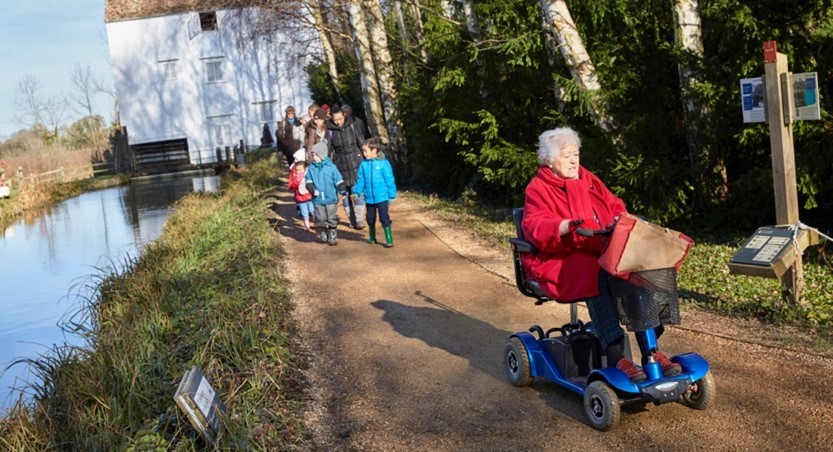It’s summer at last! The days are long, there’s a chance of some sunshine, and the kids are off school, so this is the perfect time to take the family out for the day with your Motability Scheme car or scooter. Rough Guides’ author Mandy Tomlin picks some of her favourite accessible places, including outdoor beauty spots, venues for picnics and alfresco dining, and a few indoor attractions too, just in case the British weather lets you down. Have a great day out!
EXPLORE THE GREAT BRITISH OUTDOORS
1. Anglesey Abbey, Cambridgeshire
The large, attractive gardens at Anglesey Abbey are beautiful at any time of the year, but its expansive sweeping lawns and woodlands make a particularly fine spot for a summer family picnic. While adults admire the colourful rose gardens, dahlias and wildflower meadows, children can play in the sculpture garden and willow tunnels or explore the woodland copses and working watermill. The gardens are mostly flat and there are several wheelchair-accessible walks around the grounds, from the Winter Garden walk running alongside the river to a longer woodland path that takes in a wildlife area.
2. Kew Gardens, London
The Treetop Walkway at Kew Gardens
Probably the world’s best-known botanical gardens, Kew Gardens is a great place for a summer day out, both for green-fingered parents and for inquisitive children. Admire the views from the 18-metre-high Treetop Walkway (with lift access) or ride round the gardens on the Kew Explorer land train. Learn about the life of a bee in The Hive, a 17-metre high multi-sensory sculpture, with lights and sounds triggered by a real beehive.
The Hive at Kew Gardens, a 17 metre tall multi-sensory experience, designed to highlight the extraordinary life of bees
The gardens are largely flat, with plenty of tarmac paths, so it’s easy to explore the woods, formal gardens, wild areas, lakes and banks of the Thames. From 11–16 July, the gardens hosted a series of summer evening picnic concerts, while in late August/early September, there are open-air film screenings: check the website for details of all the latest events.
Also try: The impressive gardens at nearby Stourhead in Wiltshire or Wakehurst Place, Kew’s sister gardens in Sussex.
3. Giant’s Causeway, Northern Ireland
Dramatic rock columns at Giant’s Causeway
Northern Ireland’s only UNESCO World Heritage Site, the intriguing Giant’s Causeway consists of some 40,000 basalt columns on the edge of the wild North Atlantic Sea. Formed by molten lava cooling millions of years ago, the interlocking stacks are hexagonal in shape, and a fascinating and dramatic sight. An award-winning visitor centre with level access was built in 2012: from here the accessible Green Trail runs to the cliff-top with views over the stones and the sea – where dolphins and porpoises sometimes gather – and a picnic spot en-route. The longer Blue Trail, which gives direct access to the Causeway, covers uneven ground with gravel in places, so taking the shuttle bus from the visitor centre is recommended.
Also try: The dramatic Symonds Yat gorge on the river Wye, or the semi-circular beach at Dorset’s Lulworth Cove.
TAKE A WALK ON THE WILD SIDE
4. Hengistbury Head, Dorset
Exploring Hengistbury Head nature reserve
The site of an Iron Age settlement and a once-flourishing smugglers centre, today Hengistbury Head is a beautiful nature reserve and an important place for migrating and nesting birds, such as skylarks. A flat path runs alongside Christchurch Harbour to a pretty sandspit with colourful beach huts – though children may find it more fun to take the land-train (at least one carriage has wheelchair ramps). There’s also an attractive wildlife garden and visitor centre, where webcams show the nearby animal activity – in summer, you can see who is in the various nesting boxes dotted around the headland, which currently house a pair of fluffy baby owls and a blue-tits nest. Take a picnic out onto the headland, or have lunch at the friendly Hiker Café, which has disabled parking directly outside.
5. Longleat, Wiltshire
A vast country estate and stately home, Longleat has more than enough to see and do in a day. The highlight is its drive-through safari where you can view lions, tigers, cheetahs and their cubs, rhinos, giraffes and even a elephant from the safety of your own vehicle – though the monkeys may well climb on the roof and have a closer look at you. However, make sure you don’t miss the Jungle Cruise too, a fun boat trip around an island where three gorillas live – look out in the water, too, for hippos and sea lions. Longleat has several cafés, most of which are accessible, and there’s disabled parking and accessible toilets around the estate.
6. Edinburgh Zoo, Scotland
Tigers, lions, chimps, meerkats and the UK’s only koalas and giant pandas can be seen at Edinburgh Zoo. The famous Penguin Parade – held most days at 2.15pm, when the waddling birds go walkabout around the grounds – is usually a big hit with children. Most of the zoo’s paths are accessible, though as it’s on a hill, some parts are steep or accessed by steps. The zoo provides an online accessibility map, showing which areas may be hard to get to and providing alternative routes to the animals and exhibits. Wheelchairs are available to borrow (£10 deposit).
Also try: Marwell Zoo,near Winchester, to see hundreds of animals including giraffes, penguins, hippos, cheetahs and Amur tiger triplets. Woburn Safari Park is a great day out for families too – also read our review on visiting a safari park during the quieter months.
TRANSPORT: FROM STEAM TRAINS TO FLYING CARS
7. Beaulieu House and Motor Museum, Hampshire
With its beautiful gardens, stately home, historic abbey and, of course, the National Motor Museum, Beaulieu has enough to entertain petrolheads, garden-lovers and history buffs. The highlight for children is probably the motor museum with its impressive Formula 1 cars and vintage Rolls Royces. Look out for the flying cars from the Harry Potter films, James Bond’s Jaguar, Mr Bean’s mini and some of the cars used (and destroyed) during the filming of Top Gear. All three floors of the museum and the Top Gear gallery are accessible, via ramps and lifts. Most of the gardens are flat with tarmac paths, though wheelchair-users can only explore the ground floor of the Palace House. There are accessible toilets around the grounds, disabled parking and mobility scooters to borrow (book in advance).
8. Ffestiniog Railway, Wales
Wales’ finest historic narrow-gauge railway, the Ffestiniog Railway winds its way up from the harbour at Porthmadog through picturesque countryside to the old slate mines at Blaenau Ffestiniog. Running through Snowdonia National Park, it chugs up steep gradients past stunning scenery taking around 70 minutes to cover the 14-mile journey. Some of the trains’ historic carriages are very narrow, so those with limited mobility could find them difficult to access, but all the normal service trains have wheelchair spaces and ramps. Accessible toilets are available at Porthmadog and Blaenau Ffestiniog stations.
9. National Railway Museum, York
Home to some 300 trains from the world’s fastest steam locomotive, the Mallard, to a replica of Stevenson’s Rocket and a Japanese Shinkansen bullet train, the National Railway Museum in York is a mine of information on everything to do with trains, engineering and the history of the railways. Although there are steps and different levels inside the museum itself, lifts and ramps give access to the engines and other exhibits. There are accessible toilets, disabled parking and helpful staff on hand, while scooters can be hired (£5; book in advance).
Also try: Explore the ships, warehouse and museums of the Portsmouth Historic Dockyard, including Nelson’s HMS Victory and the Mary Rose museum.
ENJOY DOCKSIDE CULTURE
10. Albert Docks, Liverpool
The Albert Docks, Liverpool’s cultural hub
With museums, galleries, restaurants, cafés and shopping, Liverpool’s Albert Docks complex is a lively area with loads to explore. It’s housed in restored historic waterfront warehouses and buildings on the banks of the Mersey. Children will find the Merseyside Maritime Museum fascinating with its exhibitions on smuggling and The Titanic, while at the International Slavery Museum they can learn about slavery, both past and present. Parents may enjoy the Tate Liverpool’s modern-art collection, or can relive their youth at The Beatles Story. Most of the dock area and the quayside is flat, though some cobbled areas may be tricky for those with limited mobility: there are lifts and/or ramped access to all floors of the Maritime Museum, which also publishes an autism-friendly guide.
Also try: There’s a new viewing platform at London’s Tate Modern with fantastic views of the river and the city. (For more on the Tate Galleries, read 7 free accessible things to do in the UK.) Alternatively, check out the interactive exhibits at At-Bristol science museum.
So make the most of this summer – pick a fun day out that suits all the family, grab a picnic and head out to explore using your Motability Scheme vehicle.
The Motability Scheme enables disabled people and their families to access a brand new car or scooter, by exchanging their mobility allowance to lease the vehicle of their choice. Find out more:
Image credits
We would like to thank the following individuals, companies and picture libraries for their kind permission to reproduce their photographs:
The Hive, Kew Gardens: Alamy Stock Photo/ Tony Watson
Giant’s Causeway: Alamy Stock Photo/ Arco Images GmbH
Albert dock in Liverpool: Dreamstime/ Shahid Khan
Walkers on the footpath over Hengistbury Head, Dorset: Alamy Stock Photo/ Paul Biggins
Kew Gardens England: Alamy Stock Photo/ Frank Naylor
![]()
![Kew_Gardens_H1XRWM_Low[1].jpg](https://images4.newscred.com/Zz02ZjEyZDhkMDE3MjkyYWQ5YzczMGQxODJjMDI0ZTFlNw==)

![Giant's_Causeway_hwj997_Low[1].jpg](https://images2.newscred.com/Zz1kZTU5Y2NiMzU2ZWY5MzViZDAzNTFlOWZmMDRlMzQ4ZA==)
![Hengistbury_Head_gge854_Low[1].jpg](https://images4.newscred.com/Zz02NGE3NDZjNTVhYWU4Yzc5MDg3YmZkNTA5ODM4ZTIwMw==)
![Albert_Dock_dreamstime_m_38737438_Low[1].jpg](https://images2.newscred.com/Zz1mNjMyMWMxZTk0ZDdlNjdkNWQ0NzBkMDJmOGMxMDEzZA==)





